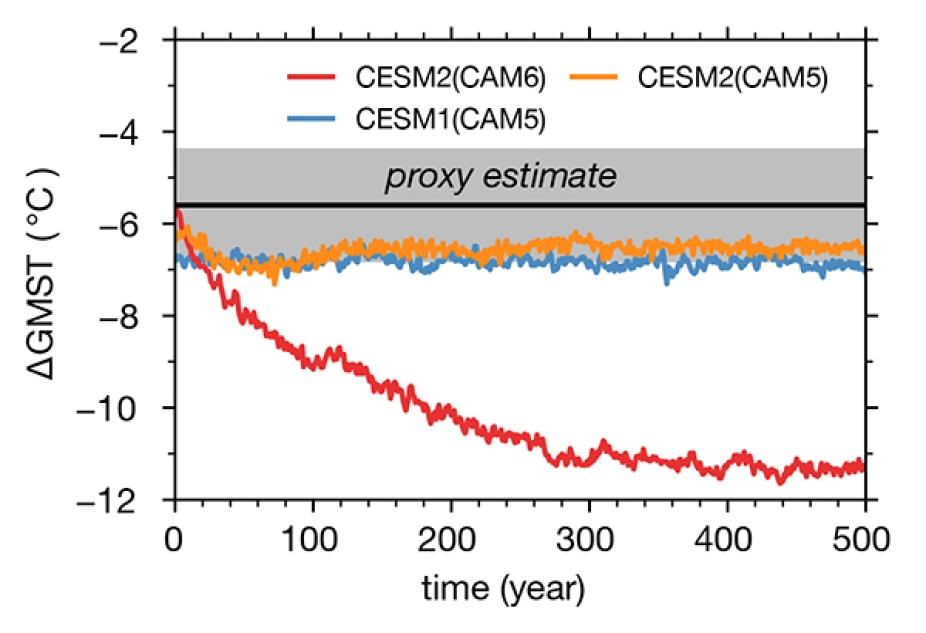CESM2 Last Glacial Maximum Simulation
The primary research goal of the LGM simulation is to assess the high equilibrium climate sensitivity (ECS) of CESM2. We used the standard CESM2 with an atmosphere/land resolution of ~1°. We find that the simulated LGM global mean temperature decrease exceeds 11°C, greater than both the cooling estimated from proxies and simulated by an earlier model version (CESM1). We attribute the excessive LGM cooling in CESM2 to an unrealistically strong shortwave cloud feedback in the newest atmosphere model. Our results suggest that the high ECS of CESM2 is unrealistic and highlight the value of using paleoclimate constraints to assess model performance.

Model-data comparison of the GMST response (ΔGMST) in the LGM simulations. The black line and the gray shading indicate the mean and the 95% confidence intervals respectively for the proxy estimates compiled by Tierney et al. (2020)
The study was highlighted by AGU's EOS Research Spotlight.
Further details are provided in the paper below (some science and technical considerations for setting up the simulation are available in the Supporting Information):
- Zhu, J., Otto-Bliesner, B. L., Brady, E. C., Poulsen, C. J., Tierney, J. E., Lofverstrom, M., & DiNezio, P. (2021). Assessment of equilibrium climate sensitivity of the Community Earth System Model version 2 through simulation of the Last Glacial Maximum. Geophysical Research Letters, n/a(n/a), e2020GL091220. https://doi.org/10.1029/2020GL091220
We kindly ask that you reference the appropriate paper(s) and acknowledge the PaleoclimateWG and computing resources from NSF and NCAR CISL when presenting results based on these simulations in either oral or written form.
Project Details
- Simulation Names:
- LGM: b.e21.B1850CLM50SP.f09_g17.21ka.01
- PI: b.e21.B1850CLM50SP.f09_g17.PI.01
- Model Versions: CESM2.1
- Resolution: 0.9x1.25_gx1v7 (nominal 1° grid)
- Years: 500 years for LGM and 300 years for PI
- Ensemble Size: one
- Time Frequencies Saved: Monthly
- Machine: NWSC Cheyenne
- Compsets: B1850
Boundary Condition Files
Boundary condition files for the ~1° LGM simulation is available on Zenodo: http://doi.org/10.5281/zenodo.4075596
Data Acquisition
The LGM and PI simulations are available on the NWSC computing storage at:
/glade/campaign/cesm/community/palwg/LastGlacialMaximum/CESM2
A very small set of the simulation data is available on Zenodo: http://doi.org/10.5281/zenodo.4075596
Please contact project lead for information on how to obtain data.
Diagnostics
Diagnostics for the LGM simulations may be added later.